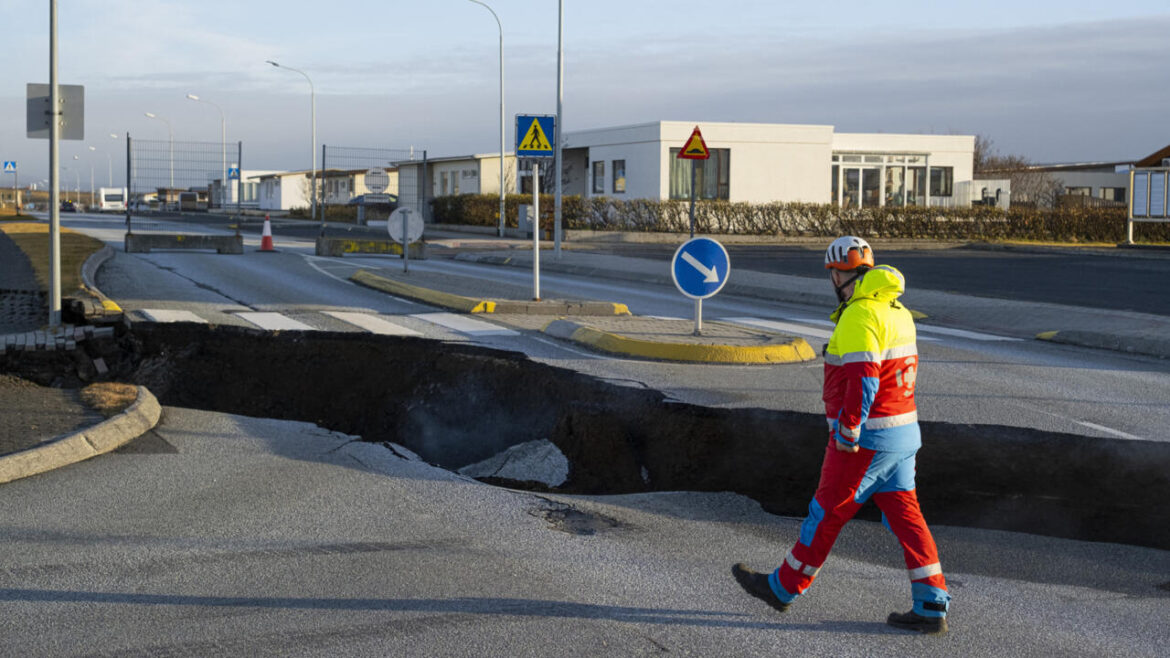In the southwest of Iceland, the risk of an imminent volcanic eruption threatens the town of Grindavik, whose 4,000 inhabitants were evacuated on November 11. However, uncertainty remains over the timing and intensity of the phenomenon. Insights from Patrick Allard, volcanologist, for France 24.
Published on :
5 mins
In a few hours, a few days, a few weeks or on the contrary, never? Since Friday November 10, the Reykjanes peninsula, in the southwest of Iceland, has been living in fear of an imminent eruption of the Fagradalsfjall volcano.
While large cracks appeared on roads and buildings and thousands of earthquakes were recorded, all signs that the volcano has awakened and that magma is approaching the earth’s surface, the Icelandic authorities have decreed the state of emergency and evacuated the 4,000 inhabitants of the town of Grindavik. The latter were only able to return home very briefly on Tuesday, November 14 to collect personal effects. As long as you only stay a few minutes and are accompanied by rescuers.
Volcanologist, emeritus researcher at the Paris Institute of Globe Physics (CNRS), Patrick Allard deciphers for France 24 this volcanic episode in progress just a few dozen kilometers from Reykjavik, the capital.
Beguiled by these photographs of roads cracked by the quakes and changing shape of the ground in and around Grindavík. Something wicked this way happens…
Source: @RuvEnglish pic.twitter.com/MYvz7TiOlk
— Dr. Robin George Andrews 🌋☄️ (@SquigglyVolcano) November 14, 2023
France 24: What is special about the current episode in the Reykjanes peninsula?
Patrick Allard: Iceland is a volcanic land: it is an island created by volcanic eruptions and is located above what is called the Mid-Atlantic Ridge – a large chain of volcanoes 15,000 km long which crosses the entire Atlantic from north to south and separates the Eurasian and North American tectonic plates.
With around thirty active volcanoes, the eruptions in this country are therefore not surprising. But the Reykjanes Peninsula remained inactive for 800 years. Volcanic activity awoke there in 2021. Since then, it has experienced one eruption per year – in March 2021, August 2022 and July 2023.
If the current episode materializes, it would therefore be the fourth eruption in three years. This is considerable. However, everything suggests that this is going to happen since we have been witnessing significant seismic activity for several days (800 earthquakes were recorded on the morning of Wednesday, November 15 alone, according to the Icelandic Meteorological Institute (IMO)) , due to a push of magma towards the surface.
This fear has persisted for almost a week now. Does the risk of a rash decrease as the days go by?
According to the latest information we have, the magma is currently between 2 and 5 km from the surface. But while the seismic activity was very intense for several days, it now seems to be slowing down. There are fewer earthquakes and they are less strong. At the same time, the ground continues to rise, move apart and collapse but in a less marked manner. This means that the magma circulates more slowly.
This can be a sign of two things: either the eruption will be aborted, or the magma will pause and will eventually reach the surface in an accelerated manner. In other words, the eruption can start suddenly and surprise us or never happen. We oscillate between these two scenarios even if that of an eruption seems much more likely.
We have many instruments to monitor the volcanic activity of an area. We have sensors to measure seismicity and magma depth. We can also know very precisely the different movements of the ground. All this allows us to anticipate the start of an eruption. But this is never certain and can always surprise us. We make forecasts, not predictions.
What are the different scenarios in the event of an eruption? Why is this episode more worrying than the previous ones?
If this eruption takes place, it will likely resemble the previous three. This will be a so-called fissural eruption. As the magma pushed toward the surface, it created fractures in the rock. Lava will spring out and flow for several kilometers.
Where the situation is worrying is that, this time, the eruption could take place near inhabited areas since a fault of almost 15 km has appeared around Grindavik. The most likely exit point for the lava is 3 km north of the city. By flowing, the magma could therefore cause damage. The eruption also threatens the large geothermal power plant located nearby, which notably helps heat the capital Reykjavik.
Furthermore, we cannot exclude that this lava exit point is even closer to the city than expected, or even directly below. This would obviously be a disaster. Grindavik would then be completely covered and wiped off the map.
Another scenario: the eruption could also take place in water, which would give rise to a hydrovolcanic eruption. We would then witness an explosion of ash and gas which will spread into the air with consequences for biodiversity, air traffic and even agricultural plots.
Regardless, everything suggests that we will not experience a scenario equivalent to 2010, with the eruption of the Eyjafjallajökull volcano, which led to a long paralysis of the air sector.
A break of 800 years and three eruptions in three years, perhaps soon four. Are we witnessing a new eruptive cycle in this area?
This is a hypothesis that is emerging. Especially since in parallel with these eruptions on the Reykjanes peninsula, Iceland has experienced several others since 2010. Specialists are beginning to think that the country is currently experiencing a cycle of significant tectonic and volcanic activity. If this is true, we will see several repeated eruptions in this area in the coming years.



